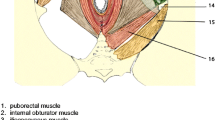Abstract
The aim of the study was to analyze the structure, relations and insertions of the pubourethral ligament in the living female. Thirty-five women, mean age 44 years, were studied. The intravaginal slingplasty (IVS) procedure, as performed via two paraurethral incisions, allowed immediate access to the structures in this area, the urethra, vaginal hammock, pubourethral ligaments and anterior portion of the pubococcygeus muscle. Histological biopsies were performed from the structures identified as ligaments. The pubourethral ligament descends like a fan from the lower part of the pubic bone. It consists of vaginal and urethral parts, joined together by thin fibrous threads, giving the appearance of a continuous sheet of amorphous connective tissue. Each part generally varies between 5 and 7 mm in width and 3–4 mm in thickness. The urethral part is approximately 2 cm long and inserts into the midpart of the urethra. The vaginal part is approximately 3–4 cm long. It inserts into the vaginal hammock posterolaterally, approximately 1 cm short of the bladder neck. Histologically the ligaments consist of smooth muscle, elastin, collagen, nerves and, blood vessels. The dissections confirm that the pubourethral ligaments are strong finite structures. Allowing for differences between cadavers and live patients, relationships and insertions are much as described by Robert Zacharin [1].
Similar content being viewed by others
References
Zacharin RF. The suspensory mechanism of the female urethra.J Anat 1963;97:423–427
Petros P, Ulmsten U. An integral theory of female urinary incontinence.Acta Obstet Gynecol Scand 1990;(Suppl 153):7–30
De Lancey JOL. Functional anatomy of the pelvic floor, and urinary continence mechanism. In: Schussler B, Laycock J, Norton P, Stanton S (eds), Pelvic floor reeducation. London: Springer-Verlag, 1994; pp 9–23
Petros PE. The intravaginal slingplasty operation, a minimally invasive technique for cure of urinary incontinence in the female.Aust NZ J Obstet Gynecol 1996;36:463–461
De Lancey JOL. Structural support of the urethra as it relates to stress incontinence: the hammock hypothesis.Am J Obstet Gynecol 1994;170:1713–1723
Wilson DD. Posterior pubourethral ligaments in normal and genuine stress incontinent women.J Urol 1982;130:802–805
Cruikshank SH, Kovac SR. The functional anatomy of the urethra: role of the pubourethral ligaments.Am J Obstet Gynecol 1997;176:1200–1205
Petros PE, Ulmsten U. An integral theory and its method for the diagnosis and management of female urinary incontinence. Theoretical, morphological, radiographical correlations and clinical perspective.Scand J Urol Nephrol 1993;27(Suppl 153):1–28
Petros PE, Ulmsten U, Role of the pelvic floor in bladder neck opening and closure: II Vagina.Int Urogynecol J 1997;18:69–73
Petros PE, Ulmsten U. Role of the pelvic floor in bladder neck opening and closure: I Muscle forces.Int Urogynecol J 1997;8:74–80
Ingelman-Sundberg A. The pubovesical ligament in stress incontinence.Acta Obstet Gynecol Scand 1949;28:183–188
Author information
Authors and Affiliations
Additional information
Editorial Comment: The ‘pubourethral ligament’ was first identified and described anatomically by Zacharin in 1961. Much debate continues regarding the existence, identification and function of this structure. The present anatomical and histological study confirms the existence of the pubourethral ligaments, ‘as described by Robert Zacharin’, as a genuine anatomical structure in vivo. The study strengthens the recently reported findings of a discrete pubourethral ligament found on cadaveric dissection by Cruikshank and Kovac. The author then speculates as to the function of this ligament in maintaining continence, although no attempt is made in the study design to answer this very important question.
Rights and permissions
About this article
Cite this article
Papa Petros, P.E. The pubourethral ligaments — an anatomical and histological study in the live patient. Int Urogynecol J 9, 154–157 (1998). https://doi.org/10.1007/BF02001085
Issue Date:
DOI: https://doi.org/10.1007/BF02001085




